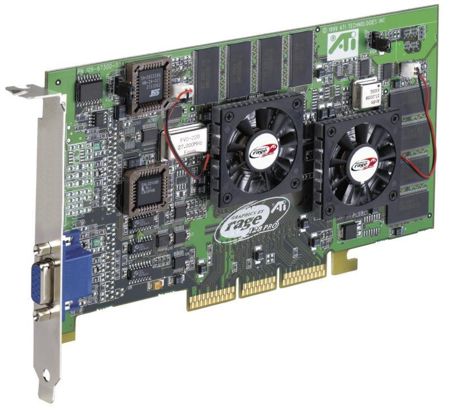ATI Radeon HD 3870 X2 - Fastest Yet!
Origins
Another forerunner, 3dfx, brought this concept to the mainstream market with its second generation of chips: the Voodoo 2 and its famous SLI (Scan Line Interleave). This chip allowed the most fortunate players to install a second accelerating card (on top of the standard video card, which could lead to taking up to 3 PCI slots for video alone) allowing double the fill rate as a whole. As the technical name suggests, the rendering is interlaced, meaning one card was rasterizing the even lines while the other took care of the odd ones. Some manufacturers like Quantum 3D, well known for having integrated two Voodoo chips on a single card, pushed the concept even further by basing them on 3dfx technology. After having integrated two Voodoo 2 chips on a single card, they linked four of them together.
Quantum 3D Mercury
It's on this monster that 3dfx held the T-Buffer demonstration.
With the arrival of AGP, multi card solutions became impossible and manufacturers went for the integration of many chips on the same card with varying degrees of success. Among those endeavors was the ATI Rage Fury MAXX, which really doesn't stand out. We'd far rather keep the Voodoo 5 5500 as a souvenir of that time, but a souvenir sadly tinged with regret, as it was the last high end graphic card from 3dfx, the 6000 version was really a Quantum 3D. After that, multi GPU solutions deserted the PCs for a while without totally disappearing as they found their place in other segments. The professional segment first and foremost, with cards like Evans&Sutherland using many R300s. Silicon Graphics itself finally resolved not to develop its own chip and used ATI's.
Rage Fury MAXX
Voodoo 5 5500
Multi chip solutions have also been used in the arcade segment and we can cite the example of the Naomi 2 from Sega, which exploited two PowerVR2 that were fed with an Elan geometric processor. Then they came back stronger than ever on the PCs with the Volari V8 Duo ... oops sorry ... the 3DLabs Realizm 800, even if this card was clearly destined to the professional market. Finally, we remember the GeForce 7950GX2, which left us with mixed feelings in the end.
Get Tom's Hardware's best news and in-depth reviews, straight to your inbox.
GeForce 7950GX2
History keeps on repeating itself, now it's AMD's turn to launch its multi GPU card, aiming to fill the hole in its high end range after the fallout left by the Radeon HD 2900 XT, following the performance-price ratio of the HD 3870. Among other things, the manufacturer faces a real problem, not owning a high-end chip and after announcing the postponement of its R700 until ... 2009! Even if there's still a small chance we'll see a hypothetical R690 this year, it's possible, when considering the recent situation of the manufacturer, that it will just use CrossFire on two R680s for its very high end in 2008. But what is this R680 really worth?



